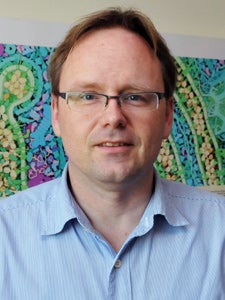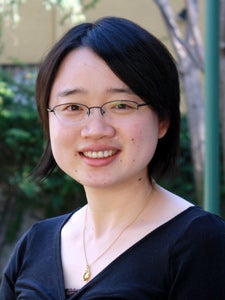Analyzing Life on a Molecular Level
Three faculty members in USC Dornsife’s Department of Biological Sciences received research grants from the National Institutes of Health (NIH) to develop and apply innovative methods to analyze data on proteins, genes and their interactions.
Research Project Grants (R01), which provide support for health-related research and development, were awarded to Frank Alber, Liang Chen and Andrew Smith, all of the department’s molecular and computational biology section.
Frank Alber, assistant professor of biological sciences, will use his five-year R01 grant to study the structures and spatial distributions of protein complexes in cells. Because cells are tightly packed, highly crowded environments, he said that exploring simultaneously the spatial distribution of thousands of these complexes will lead to a better understanding of their functional cooperation in cellular processes.

Frank Alber, assistant professor of biological sciences, studies the structures and spatial distributions of protein complexes. Photo by Laurie Moore.
“We must see these complexes in their cellular environment to understand how they cooperate in function. It’s a bit like combining words into sentences and paragraphs, and paragraphs into chapters, so that you have a greater meaning,” Alber said. “Proteins combine into complexes and organize themselves in a cell. So to get a better understanding of biological processes, we have to know how the protein complexes distribute, how many there are and so forth.”
Proteins are involved in nearly all cell functions, and complexes must be in a specific location at a specific time for a cell to function properly. He said that disease may result if this organization is disturbed.
Alber collaborates with colleagues at the European Molecular Biology Laboratory in Heidelberg and the University of Oxford. The researchers use a method called cryo-electron tomography, which takes images of a cell. Alber develops computational methods to study these intricate images in order to identify recurrent patterns. Once he finds the patterns, he combines those that are similar and averages them to create a three-dimensional image of the shapes and locations of the protein complexes within the cell. Potentially, he said, there could be thousands of these complexes to map.
Liang Chen, assistant professor of biological sciences, will use her four-year R01 grant to study alternative splicing, a gene regulation mechanism. Humans are host to an estimated 25,000 different protein-coding genes. Some genes code for only one protein, which carries out a duty in the body based on the information in that gene. But other genes use alternative splicing to increase their diversity.

Liang Chen, assistant professor of biological sciences, studies alternative splicing. Photo courtesy of Liang Chen.
Through alternative splicing, multiple protein isoforms can be formed from the same gene, and more than 90 percent of human genes undergo this process, Chen explained.
Alternative splicing is a tightly regulated genetic mechanism that is essential for many biological functions, such as nervous system development. Defects in this process can lead to disease, and Chen said that it has been probabilistically estimated that more than 60 percent of human disease-causing point mutations affect splicing.
To understand this process more, she uses statistical and computational methods to analyze vast quantities of data available from high-throughput sequencing technology.
“With this grant, our group would like to better quantify the alterative splicing events and identity the regulatory elements,” Chen said. “Eventually, we’d like to build a splicing regulatory network.” This network would build upon existing knowledge of gene transcription and add another layer to the understanding of gene regulation.
Chen and her team are working in collaboration with Michael Waterman, University Professor, USC Associates Chair in Natural Sciences and professor of biological sciences, computer science and mathematics; and Qi-Long Ying, assistant professor of cell and neurobiology from the Keck School of Medicine of USC.
Andrew Smith, assistant professor of biological sciences, will use his three-year grant to study interactions between proteins and RNA, and to develop computational methods for analyzing the resulting data.

Andrew Smith, assistant professor of biological sciences, studies interactions between proteins and RNA. Photo by Laurie Moore.
For genetic material to be expressed in an organism, DNA must be transcribed into RNA, which is translated into proteins responsible for the behaviors of cells. After genes are transcribed, many different processes determine how those RNA molecules are turned into proteins.
Proteins are also involved in the initial transcription process. Smith said that RNA-binding proteins can recognize which RNA molecules they should interact with, resulting in a complex network of precise, specific interactions. Through this project, Smith and his team are developing algorithms to uncover how that specificity is encoded.
“Ultimately my research is concerned with understanding how information is encoded in molecular sequences like DNA and RNA, and how that information gives rise to the diversity and complexity we see in all biological systems,” Smith said.
He is collaborating on the project with Luiz Penalva from The University of Texas Health Science Center at San Antonio.
Smith used a previous four-year R01 grant to develop analytic methods to interpret the epigenomic data that plays a major role in regulating the production of RNA from the DNA in the nucleus. Smith’s paper “Sperm Methylation Profiles Reveal Features of Epigenetic Inheritance and Evolution in Primates” was the cover article in the Sept. 15, 2011, issue of Cell.
To learn more about the research in USC Dornsife’s molecular and computational biology program, visit dornsife.usc.edu/bisc/molecular/home.